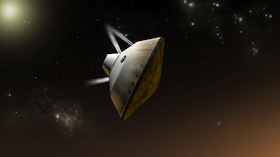NASA's sky crane over Mars

We can only guess what surprises the robotic rover Curiosity will find after the Mars Science Laboratory spacecraft delivers it to the Red Planet on August 5. Yet they will have a hard time being more immediately thrilling than the landing itself. That procedure will involve some steps so wild that they are more like something an imaginative fourth-grader might doodle on a placemat rather than a scheme hatched and realized by NASA's Jet Propulsion Laboratory (JPL) at Caltech.
The landing strategy depends on a precisely timed series of procedures that can seem both weirdly convoluted and balletically elegant, all of which must execute autonomously. It pushes the current limits of the aerospace and computational capabilities of spacecraft.
To help the public appreciate what is about to happen, NASA has released a new video, "Curiosity's Seven Minutes of Terror," that borrows its tone from adventure movie trailers. The dramatics aren't inappropriate, however, because the undertaking is difficult and the stakes are high. If the complicated landing fails and the Mars Science Laboratory is destroyed or damaged in the crash, it will set back planetary exploration badly. Scientists will then have to wait for the missions that the European Space Agency and Russia are planning to launch in 2016 and 2018.
Basically, the future study of Mars is riding on a plan that sounds crazy. But it might be just crazy enough to work.
Forbidding planet
That this landing is a daunting challenge may come as a surprise. NASA has safely placed a variety of probes on Mars in the past, from the Viking craft in 1976 and the Phoenix lander in 2008 to three previous rovers (Sojourner, Spirit, and Opportunity). It has even landed vehicles on the Moon, on Saturn's moon Titan, and on an asteroid.
Those comparisons don't hold up well, however.
Mars is a much more intimidating place to land a spacecraft than those other worlds are because its atmosphere is paradoxically too dense to ignore and too thin to exploit well. The Martian atmosphere is only about a quarter as deep as Earth's and its pressure is far lower but it still imposes a serious barrier to any spacecraft entering it at high speed.

Moreover, the planners of the Mars Science Laboratory's mission have upped the ante by trying something extra ambitious during the initial atmospheric entry phase. Normally, space probes making fiery atmospheric entries have no control over their movements, so their landing sites can be predetermined only to within hundreds of kilometers. The Mars Science Laboratory craft, however, will for the first time attempt a guided entry, with thrusters trying to keep it within 20 kilometers or so of the preferred site in the Gale Crater -- a geologically interesting area where Curiosity ought to be able to learn a lot about how water has acted on the planet throughout history. (If you have the time, in this hour-long video, NASA's Matt Golombeck describes what's so interesting about the Gale Crater site and how Curiosity will investigate it.)
Parachutes, on the other hand, find little purchase in the thin Martian air. They do work up to a point but on their own, they can't slow a descending craft enough for a soft landing. The Mars Science Laboratory vehicle will be deploying the biggest, strongest supersonic parachute NASA has ever used, but even that will only suffice to slow its descent speed from about 1,000 miles per hour down to roughly 200.
Mars probes have therefore always used retro thrusters toward the end of their descents. For the Vikings and Phoenix, the rockets brought them all the way to touchdown.
The problem with rocket-slowed landings, though, is that they inevitably disturb and contaminate the landing site and can kick up dust that might settle back onto the probe and impair it. The JPL team therefore decided with the rovers to use a thruster blast only to help check the descent velocity at a low altitude above the terrain, and then -- there's no other way to put this -- to drop them the rest of the way.
Dropping the rovers worked because they were cocooned inside the fanciest bubble wrap that JPL could engineer. Or rather, the rovers were each encased by a tetrahedron of 24 airbags that absorbed the impact, then bounced and rolled to a halt. The airbag shell then deflated and the tetrahedral case blossomed open so that the cradled rover could roll onto the relatively unpolluted surface of Mars.
It's a solution that sounds reckless but is brilliantly robust in its simplicity. It pits the strength of clever design and 21st-century materials against whatever hard-to-anticipate minor obstacles might await on the landing site. And it won't work for Curiosity because Curiosity is too big.
The Sojourner rover was a mere two feet long and weighed only 25 lbs. Spirit and Opportunity were only five feet long and weighed under 400 lbs. Curiosity is 10 feet long, almost the length of a Mini Cooper, and weighs 1,984 lbs, just under a ton, with its instrument package. To adapt Sojourner's bounce landing solution for Spirit and Curiosity, NASA had to redesign the airbags (which are made of Vectran, the same material used in space suits) to have double bladders to make them more resistant to abrasion and tears. But that adjustment already pushed what the engineers felt was the mechanical limit of the airbag solution. Stepping up the approach further for something the size of Curiosity didn't seem possible to the engineers.
Tethered to the sky
As Sherlock Holmes liked to say, "when you have eliminated the impossible, whatever remains, however improbable, must be the truth." The truth in this case was that if NASA couldn't use rockets to fly down to the surface, or a parachute to glide down, or airbags to drop down, then it had one obvious option left: it could lower the vehicle on a tether.
So NASA is planning to execute an unprecedented, Rube Goldberg-worthy maneuver called a sky crane.
When the supersonic drag chute has reached the end of its usefulness, a flat, squarish descent stage vehicle with retrorockets at its corners and the precious Curiosity rover on its belly will detach itself from the spacecraft's aeroshell. Thrust from the descent stage's rockets will sharply slow the descent further and cancel out any horizontal component of the velocity, whether from the atmospheric entry or local winds -- the goal is for the vehicle to drop as smoothly and vertically as though it were an elevator.
Twenty meters above the surface, as it continues to slowly drop, the descent stage begins lowering Curiosity at the end of at 7.5-meter system of tethers called the bridle. Two seconds after Curiosity's wheels touch the surface, sensors will trigger small charges that blast loose the bridle connections, freeing the rover. To avoid crushing the rover beneath it, the descent stage will then immediately fly away from the landing site and crash in the distance, its job done. Curiosity should be ready to roll off on its explorations of the Gale Crater.
Automated perfection only, please
The mechanics of the sky crane maneuver sound dizzying on their own, but two additional points drive home just how demanding NASA's challenge will be.
First, it's not much of an exaggeration to say that every part of the atmospheric entry, descent, and sky crane-assisted landing process needs to work perfectly. If the steering thrusters during entry don't work, if the heat shield fails to detach and give sensors a clear view of the ground, if the drag chute fails, if the descent stage can't detach, if its rockets malfunction, if the bridle doesn't deploy, if the bridle doesn't detach, if Curiosity lands with too much of a thump and breaks a wheel… the mission will be at least compromised and possibly ruined.
Second, the Mars Science Laboratory spacecraft will have to execute every part of this process entirely without human guidance. Its transit from the top of Mars's atmosphere to the surface will last only about seven minutes. Yet Mars is more than 150 million miles away from Earth, so radio signals from the spacecraft will take about 14 minutes to reach mission control. As the JPL engineers melodramatically explain in the video, by the time they hear that the procedure has started, Curiosity will have been on the ground -- either safe or smashed to bits -- for seven minutes.
Has NASA gone nuts?
The sky crane and the rest of the entry, descent, and landing process for the mission may seem so farfetched and unlikely to work that one has to wonder: was there really no more prudent way for NASA to put Curiosity on Mars? Or conversely, is this approach actually less risky than some of NASA's own descriptions of it might suggest?
The tragic fact is that Mars has defeated many space missions in the past, including some laid low by stupid miscalculations. Courting extra difficulty therefore always seems reckless. For the reasons mentioned earlier, though, I believe NASA considers the sky crane and other innovations to be the best (if not only) option.
Then, too, the risks are probably far better considered and planned against than NASA's deliberately dramatic video might imply. The individual components of the plan -- the supersonic chute, the self-navigating hovering platform, the tether, and so on -- are ones with which aerospace engineers and NASA have had some experience. Putting them together under all-or-nothing circumstances and preserving a margin of safety is the key. If JPL's engineers didn't have reasonable confidence that all the components of the landing would work, they wouldn't have put their reputations on the line for a mission that, if it should fail, will invite recriminations.
Still, nothing can be taken for granted. Will I be sweating along in sympathy with NASA during those fateful seven minutes of the probe's arrival on Mars? Count on it.
•
Top image: Descent stage of the Mars Science Laboratory vehicle, lowering the folded Curiosity rover in the sky crane maneuver. (Credit: NASA/JPL-Caltech)
This post was originally published on Smartplanet.com
